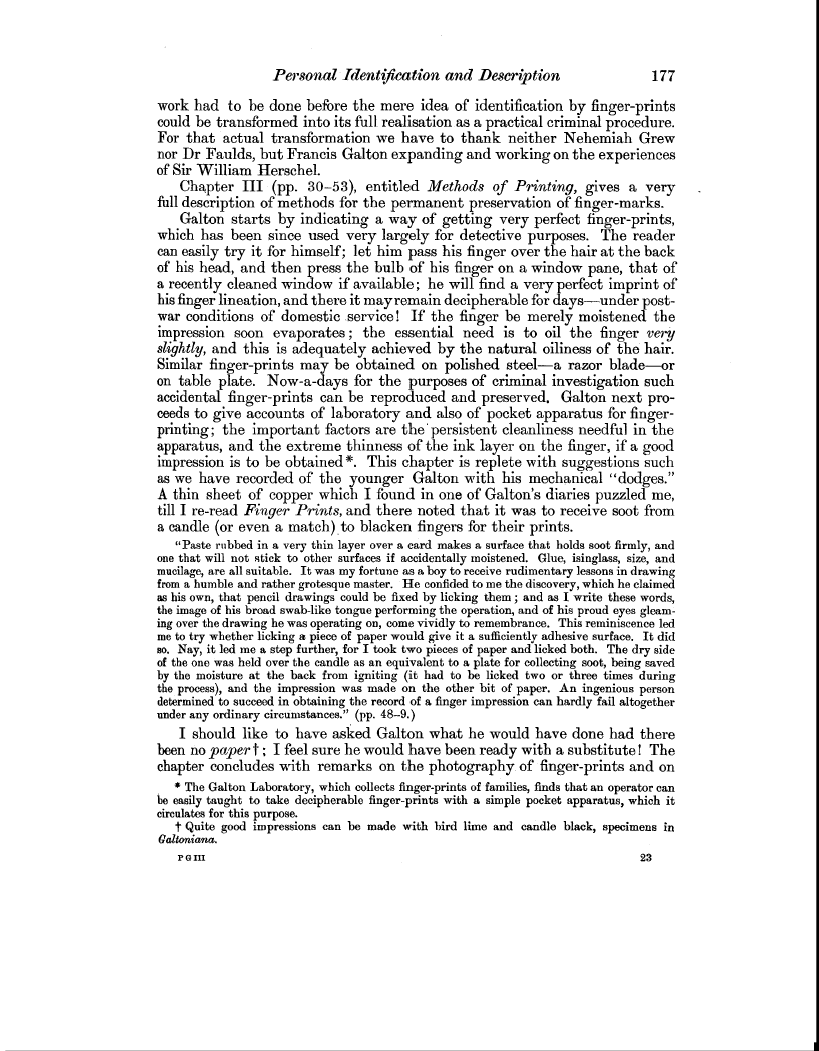| ||||||

OCR Rendition - approximate
Personal Identification and Description 177 work had to be done before the mere idea of identification by finger-prints could be transformed into its full. realisation as a practical criminal procedure. For that actual transformation we have to thank neither Nehemiah Grew nor Dr Faulds, but Francis Galton expanding and working on the experiences of Sir William Herschel. Chapter III (pp. 30-53), entitled Methods of Printing, gives a very full description of methods for the permanent preservation of finger-marks. Galton starts by indicating a way of getting very perfect finger-prints, which has been since used very largely for detective purposes. The reader can easily try it for himself; let him pass his finger over the hair at the back of his head, and then press the bulb of his finger on a window pane, that of a recently cleaned window if available; he will find a very perfect imprint of his finger lineation, and there it may remain decipherable for days-under postwar conditions of domestic .service! If the finger be merely moistened the impression soon evaporates ; the essential need is to oil the finger very slightly, and this is adequately achieved by the natural oiliness of the hair. Similar finger-prints may be obtained on polished steel-a razor blade-or on table plate. Now-a-days for the purposes of criminal investigation such accidental finger-prints can be reproduced and preserved. Galton next proceeds to give accounts of laboratory and also of pocket apparatus for fingerprinting; the important factors are the' persistent cleanliness needful in the apparatus, and the extreme thinness of the ink layer on the finger, if a good impression is to be obtained*. This chapter is replete with suggestions such as we have recorded of the younger Galton with his mechanical "dodges." A thin sheet of copper which I found in one of Galton's diaries puzzled me, till I re-read Finger Prints, and there noted that it was to receive soot from a candle (or even a match). to blacken fingers for their prints. "Paste rubbed in a very thin layer over a card makes a surface that holds soot firmly, and one that will not stick to other surfaces if accidentally moistened. Glue, isinglass, size, and mucilage, are all suitable. It was my fortune as a boy to receive rudimentary lessons in drawing from a humble and rather grotesque master. He confided to me the discovery, which he claimed as his own, that pencil drawings could be fixed by licking them ; and as I write these words, the image of his broad swab-like tongue performing the operation, and of his proud eyes gleaming over the drawing he was operating on, come vividly to remembrance. This reminiscence led me to try whether licking a piece of paper would give it a sufficiently adhesive surface. It did so. Nay, it led me a step further, for I took two pieces of paper and licked both. The dry side of the one was held over the candle as an equivalent to a plate for collecting soot, being saved by the moisture at the back from igniting (it had to be licked two or three times during the process), and the impression was made on the other bit of paper. An ingenious person determined to succeed in obtaining the record of a finger impression can hardly fail altogether under any ordinary circumstances." (pp. 48-9.) I should like to have asked Galton what he would have done had there been no paper t ; I feel sure he would have been ready with a substitute ! The chapter concludes with remarks on the photography. of finger-prints and on * The Galton Laboratory, which collects finger-prints of families, finds that an operator can be easily taught to take decipherable finger-prints with a simple pocket apparatus, which it circulates for this purpose. t Quite good impressions can be made with bird lime and candle black, specimens in Galtoniana. P 0111 23
|